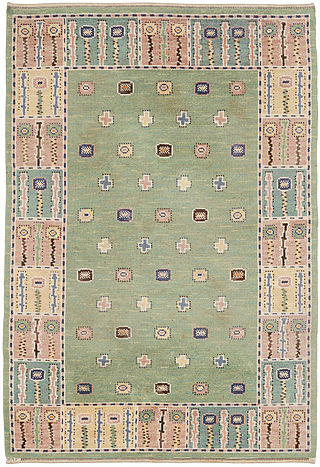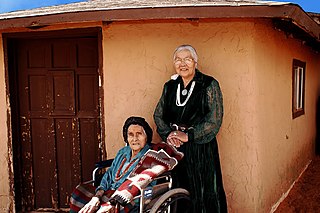
Weaving is a method of textile production in which two distinct sets of yarns or threads are interlaced at right angles to form a fabric or cloth. Other methods are knitting, crocheting, felting, and braiding or plaiting. The longitudinal threads are called the warp and the lateral threads are the weft, woof, or filling. The method in which these threads are interwoven affects the characteristics of the cloth. Cloth is usually woven on a loom, a device that holds the warp threads in place while filling threads are woven through them. A fabric band that meets this definition of cloth can also be made using other methods, including tablet weaving, back strap loom, or other techniques that can be done without looms.

A kilim is a flat tapestry-woven carpet or rug traditionally produced in countries of the former Persian Empire, including Iran, the Balkans and the Turkic countries. Kilims can be purely decorative or can function as prayer rugs. Modern kilims are popular floor coverings in Western households.

Navajo weaving are textiles produced by Navajo people, who are based near the Four Corners area of the United States. Navajo textiles are highly regarded and have been sought after as trade items for more than 150 years. Commercial production of handwoven blankets and rugs has been an important element of the Navajo economy. As one art historian wrote, "Classic Navajo serapes at their finest equal the delicacy and sophistication of any pre-mechanical loom-woven textile in the world."

Soumak is a tapestry technique of weaving sturdy, decorative fabrics used for carpets, rugs, domestic bags and bedding, with soumak fabrics used for bedding known as soumak mafrash.

Art of the American Southwest is the visual arts of the Southwestern United States. This region encompasses Arizona, New Mexico, and parts of California, Colorado, Nevada, Texas, and Utah. These arts include architecture, ceramics, drawing, filmmaking, painting, photography, sculpture, printmaking, and other media, ranging from the ancient past to the contemporary arts of the present day.

Trude Guermonprez, born Gertrud Emilie Jalowetz, was a German]-born American textile artist, designer and educator, known for her tapestry landscapes. Her Bauhaus-influenced disciplined abstraction for hand woven textiles greatly contributed to the American craft and fiber art movements of the 1950s, 60s and even into the 70s, particularly during her tenure at the California College of Arts and Crafts.

Carpets and rugs have been handmade in Sweden for centuries, taking on many different forms and functions over the course of time. Rugs woven in the traditional Oriental manner, especially in the Ottoman Empire and points east, were originally brought to Sweden over trade routes as early as the early Middle Ages. In the centuries that followed, Swedish rug-makers often infused their works with themes and motifs traditionally found in Oriental rugs. Eventually, Swedish rug-makers would begin to use Oriental rug-making techniques, but themes and motifs more consistent with the artistic and cultural heritage of Sweden. By the early modern periods, rugs had long been an important avenue of art – especially folk art – in Swedish culture. By the beginning of the twentieth century, the craft was seen as being an important artistic and cultural practice throughout Sweden, and designers began to make rugs that had a broad international appeal. Swedish rugs from the mid-twentieth century remain among the most desirable and sought after in the rug world.
Cynthia Schira is an American textile artist and former university professor. Her work is represented in the collections of many major public museums.
Irene Hardy Clark is a Navajo weaver. Her matrilineal clan is Tabaahi and her patrilineal clan is Honagha nii. Her technique and style is primarily self-taught, incorporating contemporary and traditional themes.

A lazy line or section line is a technical feature of weaving which describes visible diagonal joins within a woven textile. It results from interlacing wefts joining adjacent warp sections woven at different times. Successive rows of turnarounds of discontinuous wefts create a diagonal line which, in pile rugs, is best seen from the back side, and from the front side only if the pile is heavily worn. A lazy line is created when the weaver does not finish a rug line by line from one side to the other, but sequentially finishes one area after the other.
D.Y. Begay is a Navajo textile artist born into the Tóʼtsohnii Clan and born from the Táchiiʼnii Clan.
Melissa Cody is a Navajo textile artist from No Water Mesa, Arizona, United States. Her Germantown Revival style weavings are known for their bold colors and intricate three dimensional patterns. Cody maintains aspects of traditional Navajo tapestries, but also adds her own elements into her work. These elements range from personal tributes to pop culture references.

Grace Henderson Nez was a Navajo weaver, known for her traditional designs. Her main styles were old designs from the 19th century and Ganado style. Some of her work was demonstrated at the Hubbell Trading Post, which is home to an archive of works from various Navajo weavers. Before her death in 2006, she was able to win two lifetime achievement awards for her work, including a National Heritage Fellowship from the National Endowment for the Arts.
TahNibaa Naataanii is a Native American traditional artist and a member of the Navajo Tribe. She has espoused a belief that creativity should be allowed to be the source of art and that artists should not have to confine themselves to a particular style. Naataanii has also stated that weaving art and tradition should be passed along to present and future generations, with her art techniques and mediums being the traditional form, and artistic style dependent on the artist.
Sierra Nizhoni Teller Ornelas is a Native American showrunner, screenwriter, filmmaker and weaver from Tucson, Arizona. She is one of three co-creators of the scripted NBC (Peacock) comedy series Rutherford Falls, alongside Ed Helms and Mike Schur.
Joyce Begay-Foss is a Diné weaver, educator, and curator. She is the director of education at the Museum of Indian Arts & Culture. For her weavings, she has received more than 20 awards at the Santa Fe Indian Market and Eight Northern Pueblos arts and crafts show.
Daisy Taugelchee was a Navajo weaver. The Denver Art Museum declared Taugelchee as "widely considered the most talented Navajo weaver and spinner who ever lived". In 2004 one of her rugs was featured on a United States Postal Service stamp.

Mary Zicafoose is an American textile artist, weaver, and teacher who specializes in ikat, an ancient technique in which threads are wrapped, tied and resist-dyed before weaving. Zicafoose is the author of Ikat: The Essential Handbook to Weaving Resist-Dyed Cloth (2020). Her works are part of private and public collections, including at least 16 embassies around the world as part of the U.S. Art in Embassies Program.

Irene Emery (1900–1981) was an American art historian, scholar, curator, textile anthropologist, sculptor, and modern dancer. She was known for her pioneering research in systematically describing global textiles, and was a leading authority on ancient fabrics and textiles, and for her published book The Primary Structures of Fabrics: An Illustrated Classification (1966).

Mary Farmer was a UK-based weaver of tapestries and rugs, she led developments in tapestry in the late 20th Century with a number of roles across higher education culminating in Course Director at the Royal College of Art. Her client list included royalty, government departments, major corporations, museum collections and private collectors.












